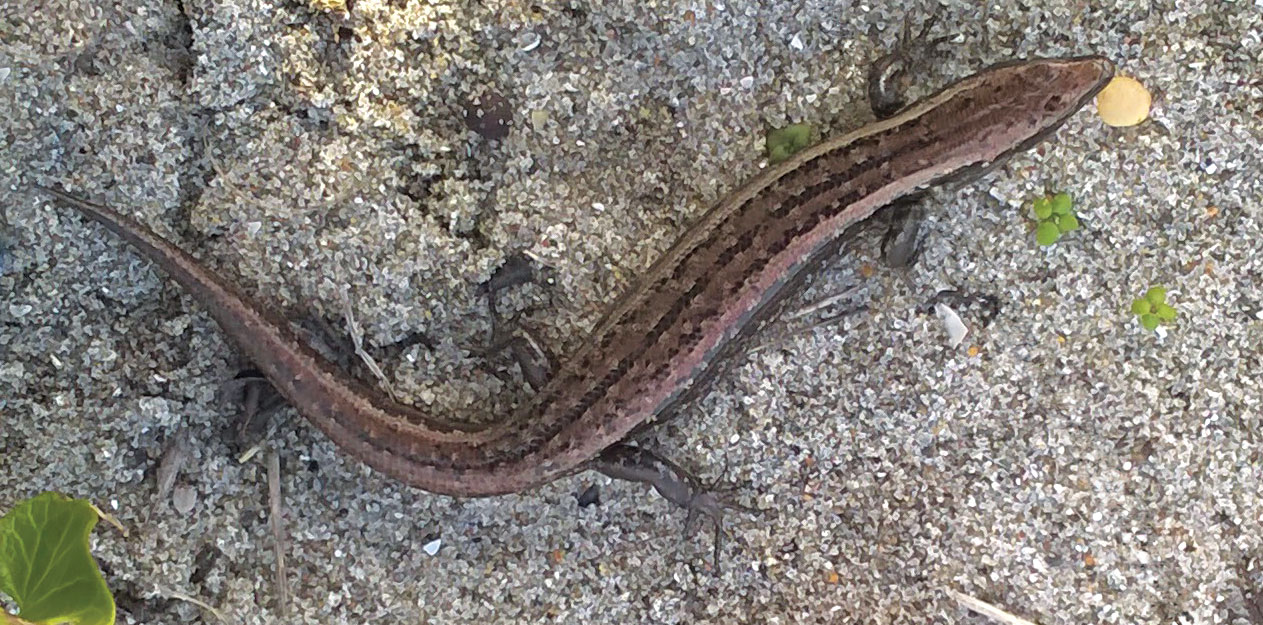Story
Mokomoko (lizard) monitoring pilot workshop
Lizards don’t always get a lot of love, but they’re a vital part of our ecosystems. Aotearoa is home to 126 species of geckos and skinks that are found nowhere else in the world.

A shore skink. Shore skinks are very similar to copper skinks, but have a longer, more pointed snout. Copper skinks have a "tear drop" pattern under the eye and distinct copper colour on the body.
Along Te Taitokerau’s coasts you might glimpse the native shore skink / mokomoko (Oligosoma smithi) or copper skink /mokomoko (Oligosoma aeneum). Both skinks, particularly the copper skink, can be easily confused with the invasive plague or rainbow skink (Lampropholis delicata). Studies indicate that this introduced lizard threatens native species with its rapid reproduction.
On 5 November, a team of kaimahi from Patuharakeke, Aki Tai Here and NRC gathered in the rohe of Patuharekeke, for a pilot workshop enabling participants to set up a lizard survey, using tracking tunnels to collect data for analysis.
Lead kaiako for the day was Jacqui Wairepo, ecologist and herpetologist (lizard and amphibian expert).
Jacqui commented; “We’ve got some cool species in the duneland ecosystem of Te Taitokerau and the workshop aims to give communities the knowledge and skills to set up their own lizard survey, so they can be proactive about finding out about the species of lizard they have in their rohe and monitoring them on an ongoing basis”.
The workshop introduced coastal lizards in Te Taitokerau, including current species, population trends, threats and how to help them survive. Jacqui emphasised important points around lizard safety – they shouldn’t be handled because it’s stressful for them and if handling is required this must be done by an individual or organisation with authority under the Wildlife Act, issued by the Department of Conservation (DOC).
Survey methods and tools were an important element of the day, including how to use tracking tunnels and how to interpret the tracks.
As well as monitoring native biodiversity, tracking tunnels show the presence of predator species that eat lizards, like rats and mice. Identifying the tiny tracks of mice, the larger prints of rats and hedgehogs and the delicate prints of lizards is a wonderful new skill to learn!
Participants in the workshop put their newfound knowledge to good use and successfully set up two monitoring transects through a mid-dune area. The tracking tunnels were placed at intervals along the lines, marked with a pink ribbon so they can be easily found.
For people with gardens on the coast, Jacqui recommends allowing “things to be a little wilder” instead of manicured. This provides a more natural habitat, which helps not only lizards but also insects, plants and birds. Coupled with active predator control, this will provide lizards with the conditions they need to thrive.
A memorable day of learning and mahi, with excellent contributions from everyone who attended.
Want to know more?
- See a full list of geckos and skinks in Aotearoa NZ, at: www.reptiles.org.nz/herpetofauna-index
- Get information on plague skink from our Pest Control Hub - plague skink
- For information on dune ecosystems, see our CoastCare - caring for Northland's dunes information
 Checking for lizards
Checking for lizards
 Setting up monitoring transects
Setting up monitoring transects
 Tracking tunnel
Tracking tunnel
 Tracking results with mice and lizard tracks
Tracking results with mice and lizard tracks
 Plague skink and mouse prints
Plague skink and mouse prints
 Possible copper skink prints in blue outline
Possible copper skink prints in blue outline
 Possible plague skink prints
Possible plague skink prints

